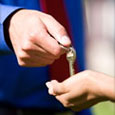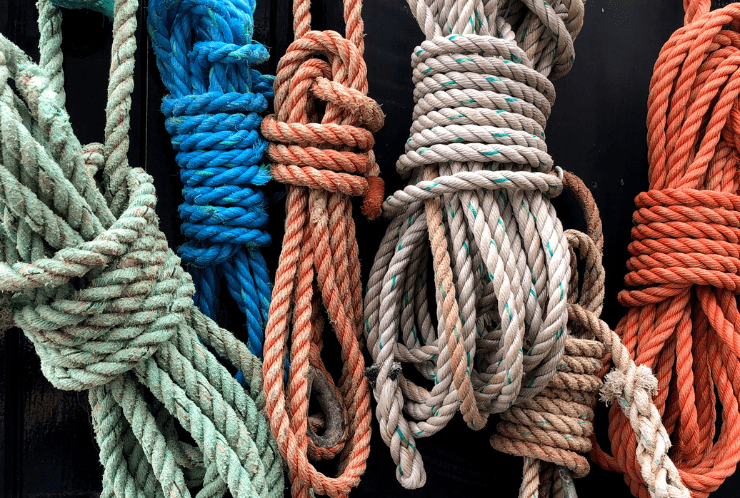
Posted by
Southwest Florida is a true fishing paradise. In addition to endless possibilities for stunning fishing locations and unique fish, the area offers many exciting activities for everyone. It’s likely you already know the basics of what you need for a successful trip, such as fishing tackle, a great rod, hooks, and fishing lines, but learning about different knots is equally essential. So, let’s go over what you need to know and what types of fishing knots are out there.
While there are many types of fishing knots, how do you determine which one to choose? The first step is to find fishing knots that offer strength and reliability. Some knots, such as the Palomar, Blood, Trilene, and Uni, are over 90% reliable and are considered “100% knots.” The ease of these types of knots would help any beginner become a pro in no time. Next, ensure that you are well prepared for your next fishing trip by reading on for some tips and tricks on how to tie them.
How Many Different Fishing Knots Are There?
Many anglers know that fishing requires more than just a great rod and reel if you want to catch a big prize. One of the essential things in any piece of fishing tackle is how strong and reliable the knots are. Imagine how disappointed you will be if you catch a trophy fish, but it slips away because you did not tie the line or hook properly.
While there are over 70 types of fishing knots, we’ll go over the most important ones. Then, the rest of this article will explain what they are and how to tie them.
Palomar Knot
The Palomar knot is probably the most common and trusted knot for many anglers who use it to tie the line to hooks or swivels. The Palomar is popular due to its strength and is also known as one of the toughest knots. In addition, an advantage of the Palomar knot is that it is relatively easy, and many people claim they can tie it in the dark with practice. While people use this knot with all fishing lines, braided fishing lines make it shine. It is effective for using lines up to 20 lb, and it is considered a “100% knot,” meaning that the line breaks before the knot.
Furthermore, the Palomar knot retains about 95% of the line’s strength, one of the highest percentages tested among all knots. However, this knot has a few disadvantages: friction might occur if it’s not wet or lubricated. Also, we don’t recommend using it with hair rigs or heavy mono lines.
How to Tie It:
- Double about 4-6 in. of line and run it through the hook’s eye
- Make an overhand knot with the hook hanging at the bottom
- Pull the end of the loop over the hook
- Moist the line and pull both ends to tighten it up
- Trim the excess line
Trilene Knot
The Trilene knot, also known as the “Two-Turn Clinch knot” or “Default knot,” is another knot used for tying a line to hooks. Like the Palomar, it’s considered a “100% knot” but retains about 90% of the line’s strength, placing it below the Palomar. Trilene knots are suitable for monofilament and fluorocarbon lines, but we don’t suggest using them for braided types.
The Trilene is known to withstand the test of time and is regarded as one of the most reliable knots used by anglers.
At first, it might take some skill and practice, but once you get used to it, it becomes second nature. To get started, simply use a big, simple hook and line.
How to Tie It:
- Thread the line through the hook’s eye. Repeat it to create a double loop
- Wrap the end around the line itself about five times (move away from the hook)
- Pass the tag through the double loop
- Moist the line and pull tight
- Trim the excess line

Improved Clinch Knot
The Improved Clinch is one of the most used knots in fishing. Many call it the “fisherman’s knot,” which is used to tie a line to hooks or swivels. As the name suggests, it’s an improved version of the Clinch knot, one of the oldest knots. The most significant advantages of this knot are that it is very dependable and easy to tie, making it ideal for beginners or leisure fishers. It’s an excellent first knot to teach your kids. The Improved Clinch scores high on reliability and strength, retaining about 90% of the line strength. It’s about 50% more reliable than the regular Clinch knot, and it’s suitable for catching and, importantly, holding on to a big fish.
Despite its reliability and strength, we do not recommend it for heavy lines (ones tested for 25-30lb and above). Also, although the Improved Clinch is ideal for mono and fluorocarbon lines, it’s not a great idea to use it for braided ones.
How to Tie It:
- Pass the line’s end through the hook.
- With the end, wrap the fishing line five or more times (move away from the hook)
- Thread the end through the first loop created and then through the bigger loop that was just created (this is the difference between the regular and improved knots)
- Wet the knot and pull both ends
- Trim the excess line
Surgeon’s Knot
When it comes to joining two lines, the Surgeon’s knot is one of the best, simplest, and most widely used. As the name suggests, surgeons use it, and it has made its way into fishing, especially fly fishing. The Surgeon’s knot is a variation of the reef knot, which dates back thousands of years. You can use this knot to tie lines of different diameters and materials. Sometimes it is referred to as the Double Surgeon’s (as it’s double tied), and there are variations like the Triple Surgeon’s knot, where you tie the lines three times. It is fast, effective, and simple, making it the go-to for beginners, children, or when your hands are cold and you have limited mobility.
However, remember that you must pull all four ends (two ends of two lines) to seal the Surgeon’s knot properly. It is also important to remember that it may not be the best option for light lines, and it might slip when connecting a braid with mono or fluorocarbon.
How to Tie It:
- Place two lines (one is the leader, and the other is the main line) next to each other and make sure they overlap by a few inches
- Make a simple loop
- Pass the end of the main line and the leader through the loop two times (for a triple, repeat one more time)
- Moist and pull all the ends to tighten the knot (you must pull all four ends for the knot to be effective)
- Trim excess line
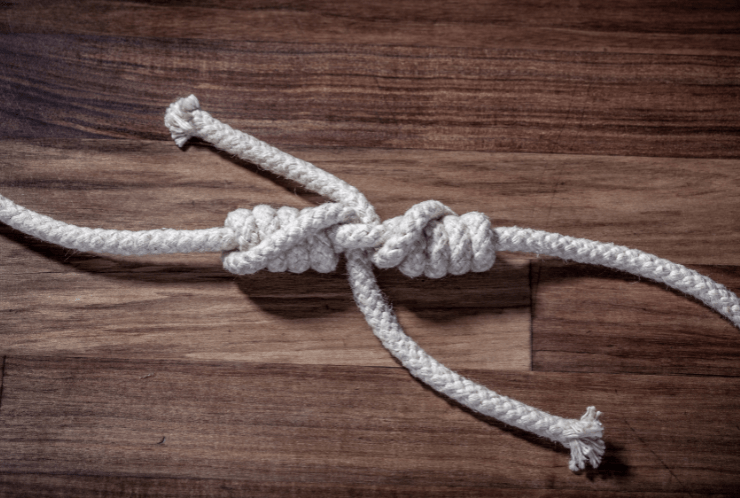
Blood Knot
Like the Surgeon’s knot, the Blood knot (also known as the Barrel knot) is one of the best line-to-line knots. The origin of the name is unknown, but it’s commonly believed that it originated from the days of the British empire. The Blood knot was used in the Cat o’nine tails, a whip that the Navy and Army used for punishment. This type of knot is much stronger than the Surgeon’s knot, but a big difference is that the Blood must be used with lines of similar size (a difference of fewer than.002 inches). It is widely used in fly fishing and with monofilament lines, but one can use it with any other type of fishing line.
One disadvantage of this knot is that it requires much more dexterity and skill to tighten than others. In addition, if not trimmed properly, it can catch on to fish rod guides. Also, if you want to use it outside of fishing, it might not be as strong if used with ropes.
How to Tie It:
- Place two lines together and make sure they overlap by a few inches
- Start with line 1 and wrap it around line 2 at least five times (the more, the better, but never less than five)
- Pass the end of line 1 through the central loop created
- Repeat step 2 for the other line in the opposite direction
- Pull the ends of both lines to tighten
- Trim the excess line
Uni Knot
The Uni knot, also known as the Duncan Loop knot or Grinner knot, is an excellent choice for securing a hook or a terminal tackle to a line and the reel’s arbor to the line. Fishers widely use this type of knot with monofilament lines, but it also works with braided or fluorocarbon lines. It’s a top choice for saltwater fishing and tuna fishing. Some advantages of this knot are that it is durable yet relatively easy to tie. Many anglers prefer it and claim it’s more durable than the improved clinch or other popular knots. Its versatility and easiness make it an ideal choice for beginners or kids.
A disadvantage to the Uni is that it might not be the best for a braided line.
You can do a double uni knot to tie two lines together. Many consider it an easier and faster alternative to the Blood Knot, but it’s not as strong.
How to Tie It:
- Thread line through the hook and double back, and create a loop with the tag end lying over the created double line
- Wrap the tag end about six times over the double line through the loop
- Wet and pull the end and tighten the knot
- Trim excess line
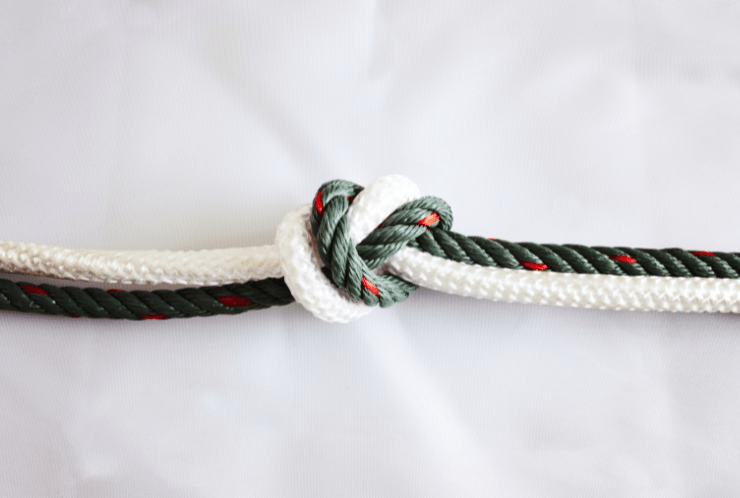
What Is the Strongest Knot for Fishing?
Even though no fishing knot is considered the strongest, a few stand out from the rest based on their intended use. When tying a hook or swivel to a line, many point to the Palomar knot as the strongest. This knot is referred to as a “100% knot,” meaning that the line will break before the knot. Estimates show that the Palomar retains about 95% of the line’s strength, arguably the highest number seen among all knots. Another advantage is that it’s relatively easy to tie, with many anglers claiming they can tie it even in the dark. In addition, it’s arguably the strongest yet still ideal for beginners. Finally, the Palomar works with all fishing lines, especially braided ones.
If you’re looking to tie two lines together, you might want to consider the Surgeon’s or Blood knot. The big difference between the two is the size difference between the lines – they must be similar for the Blood, while with the Surgeon’s, you can tie different sizes and even materials. Also, the Blood, sometimes referred to as the Barrell knot, is much stronger, but it requires skill and dexterity, while the Surgeon’s is relatively easy to tie.
What Is the Most Effective Saltwater Fishing Knot?
Southwest Florida is home to some of the best saltwater fishing in the world. From deep-sea fishing to testing your luck inshore, saltwater fishing is a rewarding and enjoyable hobby among the locals.
However, when it comes to saltwater fishing, remember that the fish tend to be larger and fiercer. That is why having a strong knot on your line is so crucial. Additionally, inshore anglers not seeking trophy fish might want to consider the Palomar knot, arguably the strongest knot, for tying hooks or swivels. The Palomar is effective for lines up to 15 or 20 lbs. The Improved Clinch knot is also great for tying hooks and swivels; after all, it’s called the “Fisherman’s knot” for a reason. It’s easy and strong (retaining about 90% of the line’s strength). This knot is rated for up to 25-30lb lines, a bit higher than the Palomar, but it’s not suited for braided lines.
Another option is the Blood knot, which is excellent for tying two lines together. It’s one of the most durable knots, and you can use it on heavier lines. It works well with mono lines, but you can use it with any type of fishing line.
However, remember that it requires some skill to tie, which is one disadvantage. Finally, the Uni or double Uni knot is another outstanding option. Again, many people use it with heavy mono lines, but it works wonderfully with a braided line and fluorocarbon. It’s an excellent option for securing a line to a hook and attaching it to the reel or other rigging equipment.
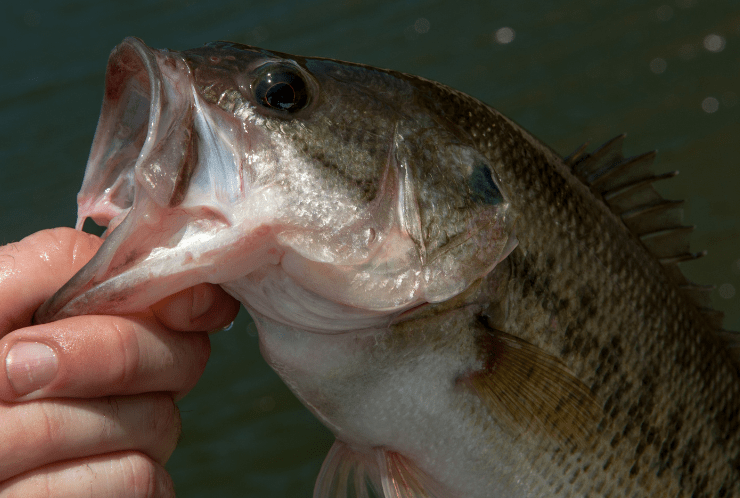
What Is the Best Knot for Bass Fishing?
There is no better place than Florida to catch bass, thanks to its countless lakes and rivers. Southwest Florida, in particular, offers many canals where the bass are plentiful. Of course, you’ve got the gear, but what is the best knot to keep this fish from escaping?
When it comes to freshwater fishing and bass, in particular, most experts agree that your go-to choices would be the Uni or the Palomar knot. The Palomar is probably the most common knot for catching bass. As mentioned before, it’s relatively easy to tie and is arguably the strongest knot.
However, the Uni knot has a loyal following, and most anglers who use it swear by it. Many claim it is more robust and more effective than the Palomar. The Uni knot is also effortless to tie and an excellent choice for beginners and kids. For joining two lines, your go-to would be the Blood knot, or if you’re not as skilled, you can go with the Surgeon’s knot or even a Double Uni knot.
What Is the Easiest Fishing Knot?
Tieing a knot might seem intimidating to beginners, but it doesn’t have to be. In fact, some of the best ones, like the Palomar, Uni, or the Improved Clinch knots, require very little skill. Each one retains nearly 100% of the line’s strength while taking virtually no time to tie, making it ideal for beginners or kids.
What Are the Best Types of Fishing Knots for Lures?
Many experts point to the improved clinch and the Uni knots as the go-to when it comes to lures. However, the Palomar knot is also an excellent choice for almost any occasion. In addition to being some of the strongest, they are also easy and fast to learn, making them a perfect choice for beginners. Depending on the type of fishing line, the Palomar might be your best choice if you use a braided line, but do not use it for lines over 15-20lb. For heavier mono lines and saltwater or deep-sea fishing, your go-to is the Uni knot. It’s easy and durable. Just be aware that the Uni does not work well with braided lines. The Improved Clinch is suitable for mono and fluorocarbon lines and is one of the easiest and oldest knots.
Get Your Bait and Tackle at the Port Sanibel Marina
When it comes to fishing around Fort Myers and all of Southwest Florida, the possibilities are endless. You can pick between various stunning inshore spots and catch plenty of unique fish. So, now that you know about the strongest and most popular types of fishing knots, you can choose one that’s right for you. But before you head out for your next catch, make sure you stop at the Port Sanibel Marina for all your tackle and live bait needs. In addition, you can also rent a boat or take a charter for an opportunity to catch the big prize in the deep waters.
